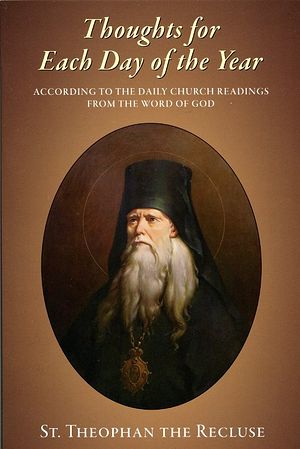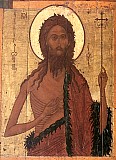

| Previous day | Next day |
| Old Style
January 7
|
Tuesday |
New Style
January 20
|
| 33rd Week after Pentecost. Tone 7. | Fast-free period.
|
![]() Afterfeast of the Theophany.
Afterfeast of the Theophany. ![]() Synaxis of the Holy Glorious Prophet, Forerunner, and Baptist John (ca.28)
Synaxis of the Holy Glorious Prophet, Forerunner, and Baptist John (ca.28)
New Hieromartyrs Paphnutius (Kostin), hieromonk of Optina Monastery (1938) and Nicholas (Parfenov), bishop of Atkarsk (1939).
St. Brannock (Brynach) of Braunton, England (6th c.). St. Cedd, bishop of Lastingham (664). New Martyr Athanasius of Attalia and Smyrna (1700).
Thoughts for Each Day of the Year
According to the Daily Church Readings from the Word of God
By St. Theophan the Recluse

Thursday (Synaxis of the Forerunner). [Acts 19:1–8; John 1:29–34]
Saint John bore witness of Christ Jesus, that He is in truth the Lamb of God, Which taketh away the sin of the world (John 1:29), that He is the promised Deliverer, awaited by all. Those who were near him heard this and believed. From them this witness passed on to the people, and everyone began to think that he of whom John bore witness was not an ordinary man. The Saviour pointed this out when in the last days in the temple, he proposed to the heads of the temple a question: whence was the baptism of John, from heaven or of men (cf. Mark 11:29)? They refrained from answering, because it was impossible for them not to see that John came baptizing with water not of himself. But if they were to say this, they would immediately have to acknowledge John’s testimony that the Promised One was before them, and therefore be compelled to submit to His teaching. But they did not want to submit, not for any well-founded reasons, but solely because of their prejudice. But their obstinacy does not in the least lessen the power of the witness of St. John. To this day, it is as certain as it was when it came forth from his mouth. We hearken unto John who shows us the true Deliverer; and through this we enliven our faith, as a faith which has tangible proof behind it.
Tuesday. [James 3:1–10; Mark 11:11–23]
The Lord took away His blessing from the fig tree which was rich with leaves but had no fruit, and it dried up. This is a lesson in action. The fig tree represents people who in appearance are proper, but in essence are not worthy of approval. Who are these people? They are those who eloquently discourse about the faith, but do not have that faith—they hold the objects of faith in the intellect only. They are those whose outward behaviour is proper but their feelings and dispositions are very improper, and they manifest proper works only to hide their impropriety from people; whenever possible, they do not do these works. For example, such a person gives alms when someone asks of him in front of people, but ask him in private and he will berate you. He goes to church to pray to God, prays in sight of everyone, and prays at home as well, so as to not bring shame upon himself before his household. But as soon as he is alone, he does not even make the sign of the cross over his brow. He does not have any idea about turning to God with the mind and heart. Let us pray that God will not allow us to be as these. For then we will not escape the judgement pronounced over the fig tree.
